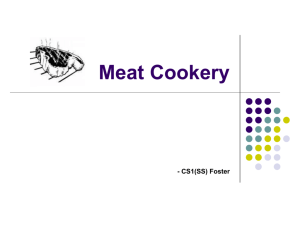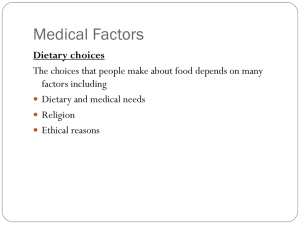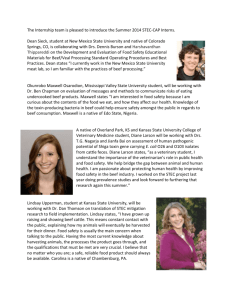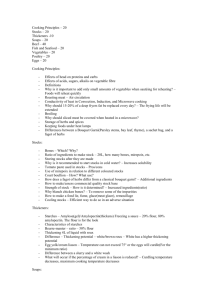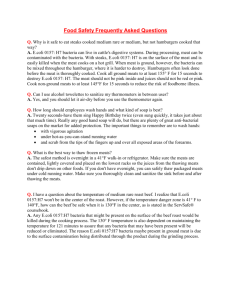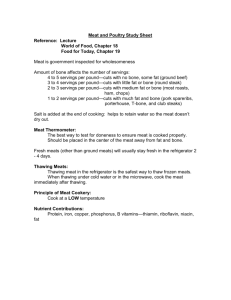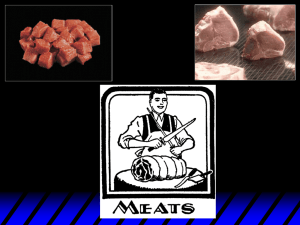Handling Ground Meats Safely
advertisement
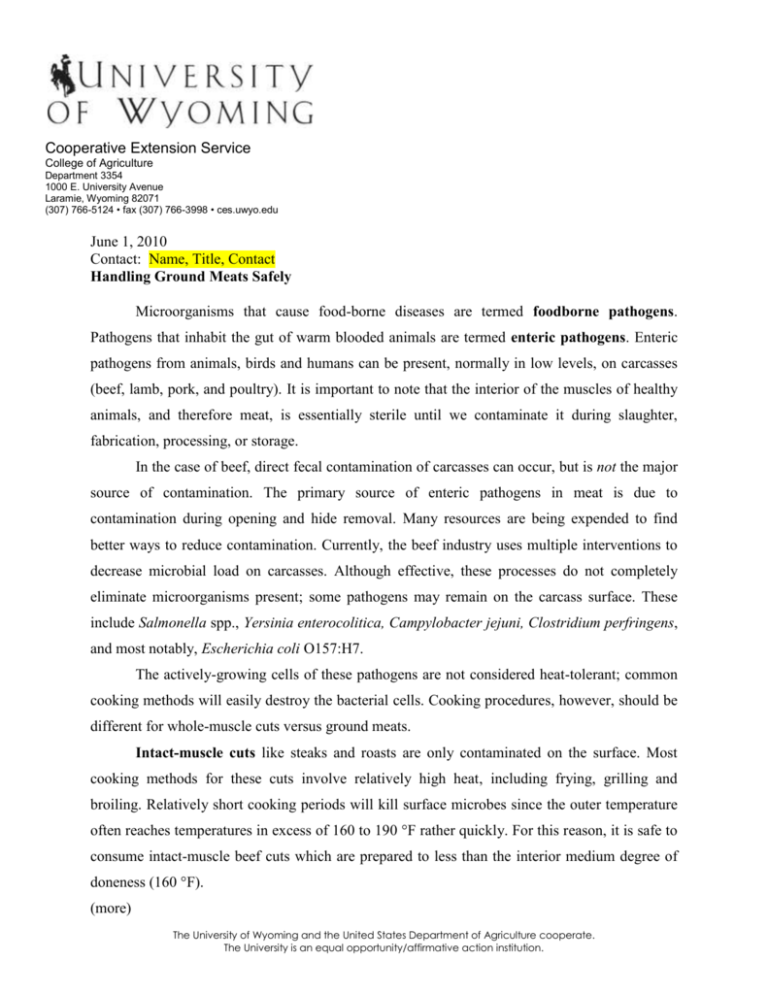
Cooperative Extension Service College of Agriculture Department 3354 1000 E. University Avenue Laramie, Wyoming 82071 (307) 766-5124 • fax (307) 766-3998 • ces.uwyo.edu June 1, 2010 Contact: Name, Title, Contact Handling Ground Meats Safely Microorganisms that cause food-borne diseases are termed foodborne pathogens. Pathogens that inhabit the gut of warm blooded animals are termed enteric pathogens. Enteric pathogens from animals, birds and humans can be present, normally in low levels, on carcasses (beef, lamb, pork, and poultry). It is important to note that the interior of the muscles of healthy animals, and therefore meat, is essentially sterile until we contaminate it during slaughter, fabrication, processing, or storage. In the case of beef, direct fecal contamination of carcasses can occur, but is not the major source of contamination. The primary source of enteric pathogens in meat is due to contamination during opening and hide removal. Many resources are being expended to find better ways to reduce contamination. Currently, the beef industry uses multiple interventions to decrease microbial load on carcasses. Although effective, these processes do not completely eliminate microorganisms present; some pathogens may remain on the carcass surface. These include Salmonella spp., Yersinia enterocolitica, Campylobacter jejuni, Clostridium perfringens, and most notably, Escherichia coli O157:H7. The actively-growing cells of these pathogens are not considered heat-tolerant; common cooking methods will easily destroy the bacterial cells. Cooking procedures, however, should be different for whole-muscle cuts versus ground meats. Intact-muscle cuts like steaks and roasts are only contaminated on the surface. Most cooking methods for these cuts involve relatively high heat, including frying, grilling and broiling. Relatively short cooking periods will kill surface microbes since the outer temperature often reaches temperatures in excess of 160 to 190 °F rather quickly. For this reason, it is safe to consume intact-muscle beef cuts which are prepared to less than the interior medium degree of doneness (160 °F). (more) The University of Wyoming and the United States Department of Agriculture cooperate. The University is an equal opportunity/affirmative action institution. Ground meats are different and require more careful cooking procedures. Ground beef, for example, is made by grinding larger pieces of meat through a small grinder plate. This process redistributes microorganisms that are present on the surface throughout the product. The result is that ground meat products contain bacteria on the surface as well as the interior. For this reason, ground meat products should be cooked to a minimum temperature of 160 °F as measured in the center of the product, as measured with a food thermometer. Tips for proper thermometer use include: Clean and sanitize thermometers before use. Insert into the center of the product, the thickest or slowest cooking part of the product. Insert the thermometer to the recommended depth, sometimes as much as 2 inches. Use only properly calibrated thermometers. Electronic thermometers are acceptable, as long as they are properly calibrated. Use thermometers regularly. Avoid cross contamination. Do not use the same utensils for handling the cooked and raw product. Wash all utensils used for raw products with warm soapy water, and rinse prior to using for the cooked product. To deter microbial growth, it is essential to limit the amount of time that the ground meat is exposed to warm temperatures. Recommended methods for thawing frozen ground beef include: The best method to thaw frozen ground beef is in the refrigerator. This may require more than one day, depending on product thickness; Submerging in cold water after the product is placed in a water tight plastic bag; Thawing in a microwave oven (The entire product should be immediately cooked.); or Cooking from the frozen state. Do not thaw on the kitchen counter! The Fight BAC!® campaign (http://www.fightbac.org/), stresses four simple steps that are critical to food safety: Clean: Wash hands and surfaces often; Separate: Don't cross-contaminate; Cook: Cook to proper temperatures; and Chill: Refrigerate promptly. Extension Column Handling Ground Meats - Page 2 of 3 The Wyoming Food Safety Coalition (WFSC) is dedicated to preventing food borne illness. This collaborative program is sponsored by the University of Wyoming Cooperative Extension Service, Wyoming Beef Council, Department of Agriculture (WDA), Department of Health, Environmental Health Association, and Lodging and Restaurant Association. For information about food safety or the WFSC, please contact your local county Extension office; WDA Consumer Health Specialist; or City-County Health Department. Source: Warrie J. Means, Ph.D., Extension Specialist in Meat Science and Food Technology, Department of Animal Science, College of Agriculture and Natural Resources, University of Wyoming. means@uwyo.edu, 307-766-5283 Used with permission. Extension Column Handling Ground Meats - Page 3 of 3




